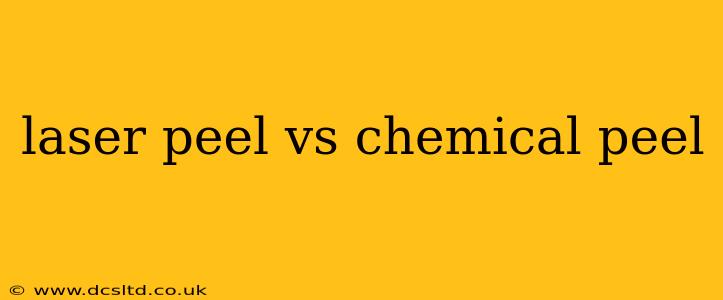Choosing between a laser peel and a chemical peel can feel overwhelming. Both treatments aim to rejuvenate the skin, reducing wrinkles, acne scars, and age spots, but they achieve this through different mechanisms. Understanding the key differences will help you make an informed decision about which procedure best suits your needs and skin type.
What is a Chemical Peel?
A chemical peel uses a chemical solution to exfoliate the skin. The depth of penetration, and therefore the level of exfoliation, varies depending on the type of chemical used. Superficial peels target the epidermis (outermost layer of skin), medium-depth peels reach the dermis (middle layer), and deep peels penetrate further into the dermis. Commonly used chemicals include alpha-hydroxy acids (AHAs) like glycolic acid and lactic acid, and beta-hydroxy acids (BHAs) like salicylic acid. The choice of peel depends on your skin concerns and your dermatologist's assessment.
What are the benefits of a chemical peel?
- Relatively less downtime: Compared to laser peels, chemical peels often require less recovery time, depending on the depth of the peel.
- Cost-effective: Generally, chemical peels are less expensive than laser peels.
- Suitable for various skin concerns: They can address a range of issues, from mild acne to sun damage and fine lines.
- Minimal invasiveness: The procedure is relatively simple and minimally invasive.
What is a Laser Peel?
A laser peel utilizes a laser beam to remove the top layers of skin. The intensity and wavelength of the laser determine the depth of skin removal. Ablative laser peels remove significant amounts of skin tissue, while non-ablative laser peels target deeper layers without removing the skin's surface. Laser peels offer more precise control over the treatment area and depth of penetration than chemical peels.
What are the benefits of a laser peel?
- More precise treatment: Lasers offer greater precision, allowing for targeted treatment of specific areas.
- Improved collagen production: Many laser peels stimulate collagen production, leading to firmer, smoother skin.
- Effective for deeper wrinkles and scars: Ablative laser peels can effectively treat deeper wrinkles and scars that chemical peels might not address as effectively.
- Potential for more dramatic results: While requiring more downtime, ablative laser peels can often produce more dramatic results.
What are the side effects of chemical peels?
Side effects of chemical peels vary depending on the depth of the peel and individual skin sensitivity. They can include redness, swelling, peeling, and temporary changes in skin pigmentation. More intense peels may result in longer recovery times and a higher risk of complications.
What are the side effects of laser peels?
Side effects of laser peels also depend on the type of laser used and the depth of treatment. Common side effects include redness, swelling, bruising, crusting, and temporary changes in skin pigmentation. As with chemical peels, more aggressive treatments carry a higher risk of complications. It's crucial to discuss potential side effects with your dermatologist before undergoing either procedure.
Which is better for acne scars?
Both chemical peels and laser peels can be effective for acne scars, but the optimal choice depends on the severity and type of scarring. For shallow acne scars, a chemical peel may suffice. However, deeper, more pitted scars might benefit more from a laser peel, particularly ablative laser treatments that can resurface the skin.
Which is better for wrinkles?
Similar to acne scars, the best treatment for wrinkles depends on their severity and depth. Superficial wrinkles can respond well to chemical peels, while deeper wrinkles often require the more intense resurfacing capabilities of a laser peel.
Which procedure has less downtime?
Generally, chemical peels, especially superficial peels, have less downtime compared to laser peels. The recovery time for laser peels, particularly ablative ones, can be significantly longer, involving several days to weeks of redness, swelling, and peeling.
Which treatment is more expensive?
Laser peels typically cost more than chemical peels. The price difference stems from the technology involved, the complexity of the procedure, and the often longer treatment time.
Choosing the Right Treatment
Ultimately, the best choice between a laser peel and a chemical peel depends on your individual needs, skin type, and the specific concerns you want to address. A thorough consultation with a qualified dermatologist or plastic surgeon is crucial. They can assess your skin, discuss your goals, and recommend the most appropriate treatment plan for optimal results and minimal risk. Remember to ask questions and fully understand the procedure before making a decision.
